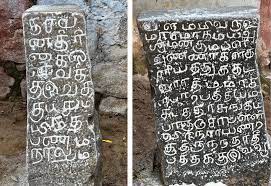January 27, 2024
Unveiling the Grantham Inscriptions: Tracing the Historical Scripts
Introduction:
• In a recent archaeological discovery near Kangayam, the Pazhnchervazhi village revealed two stone inscriptions of ‘Grantham’ and Tamil, dating back to the 11th and 16th centuries, respectively. This significant find sheds light on the historical importance of the Grantha script and its evolution in Tamil Nadu.
Exploring Grantha Script:
Historical Significance:
• Grantha, once a prominent script for writing Sanskrit across South East Asia and greater Tamil Nadu, held a crucial role in literary works. The very name ‘Grantha’ in Sanskrit signifies ‘a literary work,’ indicative of its association with Sanskrit writings.
Spread Across South India:
• The script was widely prevalent throughout South India, finding adoption as Arya Ezhuthu when Malayalam began incorporating Sanskrit words and grammar rules.
Similarities with Tamil Script:
• Both Grantha and Tamil scripts exhibit modern similarities, evolving from Brahmi. The development of Grantha script in Tamil Nadu unfolded across four distinct periods: archaic and ornamental, transitional, mediaeval, and modern.
Evolution of Grantha Script:
Archaic and Ornamental Variety:
• Known as Pallava Grantha, this early form is showcased in inscriptions like Mahendravarman’s Tiruchirapalli rock cut cave and other cave temple inscriptions, Narasimhan’s Mamallapuram, Kanchi Kailashnath, and Saluvankuppam temple inscriptions.
Transitional Variety:
• Inscriptions between 650 CE and 950 CE represent the transitional variety. Examples include those from the later Pallavas (Nandivarman’s Kasakudi, Udayendram plates) and Pandyan Nedunjadaiyan’s Anaimalai inscriptions.
Mediaeval Variety:
• Dating from about 950 CE to 1250 CE, the mediaeval variety is exemplified by inscriptions from the imperial Cholas of Thanjavur.
Modern Variety:
• Belonging to the later Pandyas and Vijayanagar periods, the modern variety of Grantha script persisted in Tamil Nadu until the early 20th century.
Legacy and Decline:
• With the advent of printing machines, Grantha script gained renewed importance as many Sanskrit books transcribed from palm leaves were printed. However, post-Independence, the rise of Hindi in Deva Nagari script led to a decline in the popularity of Grantha, eventually fading into obscurity.
Conclusion:
• The Grantham inscriptions unearthed in Pazhnchervazhi village provide a captivating glimpse into the historical journey of the Grantha script. From its origins to its decline, the script’s legacy is intertwined with the rich cultural tapestry of Tamil Nadu, leaving an indelible mark on the region’s linguistic and literary heritage.
January 30, 2025
January 20, 2025
January 14, 2025

